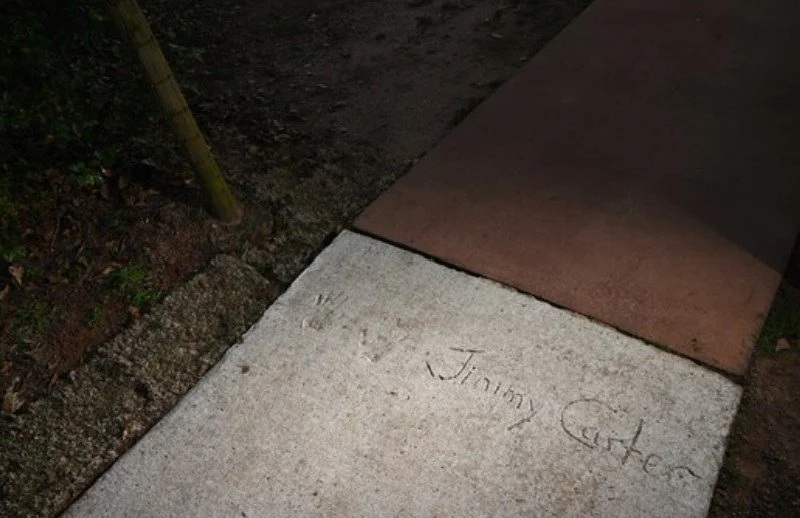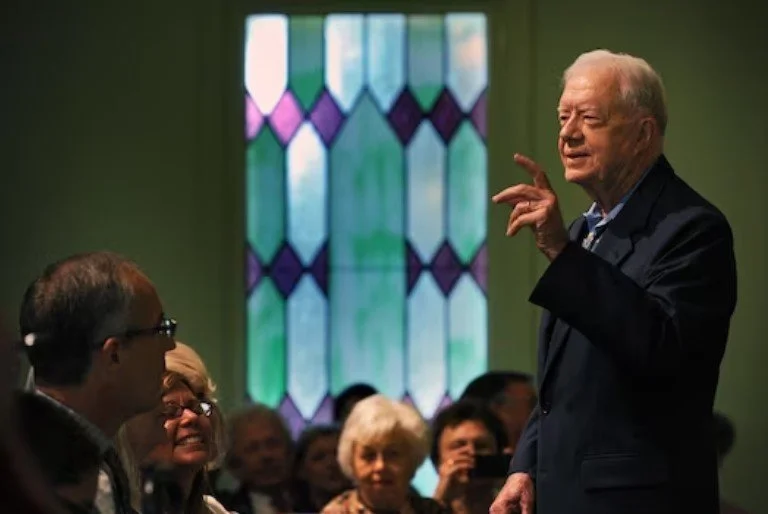Jimmy Carter’s grace and vulnerability
Robin Givhan Washington Post February 22nd 2023
The photographs of President Jimmy Carter during his time in the White House aren’t unlike those of other men who’ve held that office. Mostly they are dignified snapshots of him shaking hands with dignitaries and voters, offering up that big, gleaming expression of geniality that was his signature, walking across a tarmac or delivering a speech. It’s the images of him in his post-presidency that set him apart.
In these later public roles — builder and teacher and husband to his beloved Rosalynn — their very ordinariness makes them extraordinary. They tend to capture a man full of vulnerability.
And at the end of his life, Carter, 98, allowed this vulnerability to have an even more pronounced role in his life story when he announced Saturday that he would enter hospice care. That, too, is extraordinary.
In the modern era, it’s unusual for someone who has soared to great heights to allow himself to be seen once again negotiating life at ground level in all its uncertainty and complexity. The men who have been president depart the White House and return to someplace larger than what they left when they began their journey to the Oval Office. Perhaps that place is a home that is visibly more luxurious, more expensive, more stately. Perhaps it’s merely a mind-set that’s made plain through the company that they now keep; they’re surrounded by the famous and privileged. Perhaps they aim to make amends for history — or even rewrite it.
Carter’s signature and hand prints are in the sidewalk at the Jimmy Carter Boyhood Farm in Plains, Ga. (Matt McClain/The Washington Post)
But Carter’s return to Plains, Ga., after his single term in Washington, leaves an indelible memory of modesty and fallibility — even as he continued to achieve great things. He won the Nobel Peace Prize in 2002. He established the Carter Center in Atlanta. Yet, some of the most enduring images are those of him helping to build homes with Habitat for Humanity. He doesn’t look especially skilled or adept even though he studied engineering. He’s just a white-haired man in a plaid shirt, work gloves and a hard hat helping to raise a frame on a modest house. He’s part of a group rather than separated from it. He’s engaged in the same work as those around him and if they’re in awe of the former president, their fascination is masked by their own attention to their hammer and nails, and their little piece of the project.
Carter was a Sunday school teacher. And while it’s not unusual for a former president to regularly attend church service or find a way to engage in an act of charity to mark Christmas or Thanksgiving, Carter wasn’t simply showing up. He was not merely a congregant. He was actively educating and questioning. He was taking a lead in a conversation about faith, not from a lofty perch in a pulpit, but at eye level. He was engaged in the task of sorting through the gospel and trying to understand it. He was searching.
Carter addresses members and visitors to Maranatha Baptist Church in 2010. (Bill O’Leary/The Washington Post)
Now, as the country, and perhaps even the world, considers his life, he is also allowing us an opportunity to consider what it means to die. Not suddenly or violently, but after a long and prosperous life. After a good life. Carter has grasped a whisper of control over his own death by ceding control: to God, to fate, to the inevitable. For anyone who has conquered seemingly impossible hurdles, it must take tremendous strength to make the decision that the time has come to stop struggling and to simply be. In a time when technology promises that most anything is possible, he has allowed himself to be wholly human.
In this age of social media, the famous tell their stories in real time and so it’s not unusual to learn about the ways in which they’re fighting a momentous personal demon or facing down a health struggle. The culture reads a lot about the battles that are won — and the ones that are bravely fought but ultimately lost. But rarely is there an opportunity to consider when a battle is no longer warranted. Rarely are we reminded that sometimes saying “enough” is both powerful and empowering. Rarely are we asked to sit with the specter of death and then accept it. This is a lesson.
As a culture, so much energy is rightfully focused on the ways in which life can be prolonged just a little bit longer, the body rejuvenated if only by a few degrees. The focus is on fixing the physical. The spirit too often is left adrift. Carter reminds us that the spirit requires care and concern, too. He reminds us that sometimes the spirit needs to take precedence.
Hospice care is not a matter of giving up. It’s a decision to shift our efforts from shoring up a body on the verge of the end to providing solace to a soul that’s on the cusp of forever. The choice seems of a piece with the way in which Carter has lived in the aftermath of the presidency. His attentions were focused on ending suffering and enabling peace. He aimed to do those things through his advocacy and his activism on an international scale.
But he also demonstrated what it can mean when one turns those same considerations inward.
Jimmy Carter: The life of the 39th president
The latest: As Jimmy Carter chose to spend his final days in hospice care at home in Plains, Ga., his tiny hometown is bracing to say goodbye. As tributes celebrate his legacy, here’s a look at the life of former president Jimmy Carter.
The un-celebrity president: Jimmy Carter’s simple and modest lifestyle was rare, in sharp contrast to his successors. He declined the corporate board memberships and lucrative speaking engagements and decided that his income would come from writing. He wrote 33 books and has helped renovate 4,300 homes for Habitat for Humanity.
Rosalynn and Jimmy Carter: The Carters were married 76 years, the longest in presidential history. Their love story blossomed in World War II and survived the searing scrutiny of political life. Rosalynn Carter expanded the role of first lady.
https://www.washingtonpost.com/nation/2023/02/21/jimmy-carters-grace-vulnerability/

